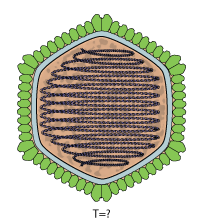Portogloboviridae
Appearance
| Portogloboviridae | |
|---|---|

| |
| Portoglobovirus virion | |
| Virus classification | |
| (unranked): | Virus |
| Realm: | Varidnaviria (?) |
| Family: | Portogloboviridae |
Portogloboviridae is a
capsid proteins of these viruses and their characteristics are of evolutionary importance for the origin of the other Varidnaviria viruses since they seem to retain primordial characters.[1]
Description
The
proteins ranging from 20 to 32 kDa. Of these proteins, 8 code for the capsid and two for the viral envelope, including one that is a vertical single jelly roll (SJR) capsid protein. Entry into the host cell is by penetration. Viral replication occurs by chronic infection without a lytic cycle.[2]
The Portogloboviridae viruses together with Halopanivirales have evolutionary importance in the evolution of the other Varidnaviria viruses since they appear to be relics of how the first viruses of this realm were. Portogloboviridae together with Halopanivirales may have infected the last universal common ancestor (LUCA) and originated before that organism.[1]
It has been proposed that it may be related to the origin of Varidnaviria in the following way.[1]
| Varidnaviria |
| ||||||||||||
Taxonomy
The family has one genus which has two species:[3]
- Alphaportoglobovirus
| Name | Name | Abbr | GenBank | REFSEQ |
|---|---|---|---|---|
| Alphaportoglobovirus SPV2 | Sulfolobus polyhedral virus 2 | SPV2 | MK064567 | NC_055116 |
| Sulfolobus alphaportoglobovirus 1 | Sulfolobus polyhedral virus 1 | SPV1 | KY780159 | NC_038017 |
References
- ^ S2CID 220516514. Retrieved 22 October 2020.
- PMID 28424284.
- ^ "Virus Taxonomy: 2022 Release". International Committee on Taxonomy of Viruses (ICTV). March 2023. Retrieved 20 August 2023.
